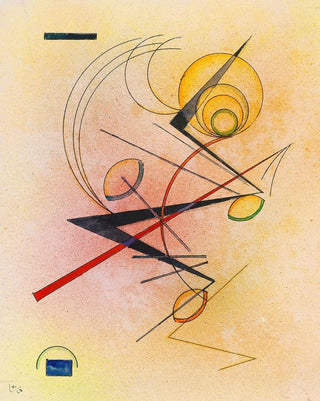Art print | Petit chaud - Wassily Kandinsky


View from behind

Frame (optional)
In the vibrant universe of modern art, "Petit chaud" by Wassily Kandinsky stands out for its boldness and depth. This iconic piece, born from the imagination of a pioneer of abstraction, invites a sensory exploration where colors and shapes intertwine to create a unique visual experience. Contemplating this work, the viewer is transported into a lively world, where each nuance seems to tell a story. The title "Petit chaud" evokes subtle warmth, an intimacy expressed through shades and movements. This piece is not merely a simple representation; it becomes a dialogue between the artist and the observer, an invitation to feel and reflect.
Style and uniqueness of the work
Kandinsky's style is characterized by an innovative approach, where abstraction takes precedence over figurative representation. In "Petit chaud," warm colors dominate, creating an enveloping and comforting atmosphere. Organic and geometric shapes blend harmoniously, revealing a dynamic structure that captures the eye and stimulates the imagination. The work is marked by a subtle balance between chaos and harmony, where each element seems to have its place within a coherent whole. Brushstrokes, both spontaneous and thoughtful, demonstrate the artist's technical mastery while revealing raw emotion. This blend of rigor and freedom gives "Petit chaud" a singularity that makes it an essential piece of modern art.
The artist and his influence
Wassily Kandinsky, born in Russia in 1866, is often regarded as one of the founders of abstract art. His artistic career, characterized by constant evolution, reflects an ongoing quest for new forms of expression. Influenced by music, he sought to create works that resonate like sound compositions, where each color and shape evoke specific emotions. His commitment to abstraction paved the way for many artists, and his legacy endures in the world of contemporary art. Through his writings and works, Kandinsky conveyed the importance of spirituality in art, inviting everyone to connect with their own emotions. "Petit

Matte finish

View from behind

Frame (optional)
In the vibrant universe of modern art, "Petit chaud" by Wassily Kandinsky stands out for its boldness and depth. This iconic piece, born from the imagination of a pioneer of abstraction, invites a sensory exploration where colors and shapes intertwine to create a unique visual experience. Contemplating this work, the viewer is transported into a lively world, where each nuance seems to tell a story. The title "Petit chaud" evokes subtle warmth, an intimacy expressed through shades and movements. This piece is not merely a simple representation; it becomes a dialogue between the artist and the observer, an invitation to feel and reflect.
Style and uniqueness of the work
Kandinsky's style is characterized by an innovative approach, where abstraction takes precedence over figurative representation. In "Petit chaud," warm colors dominate, creating an enveloping and comforting atmosphere. Organic and geometric shapes blend harmoniously, revealing a dynamic structure that captures the eye and stimulates the imagination. The work is marked by a subtle balance between chaos and harmony, where each element seems to have its place within a coherent whole. Brushstrokes, both spontaneous and thoughtful, demonstrate the artist's technical mastery while revealing raw emotion. This blend of rigor and freedom gives "Petit chaud" a singularity that makes it an essential piece of modern art.
The artist and his influence
Wassily Kandinsky, born in Russia in 1866, is often regarded as one of the founders of abstract art. His artistic career, characterized by constant evolution, reflects an ongoing quest for new forms of expression. Influenced by music, he sought to create works that resonate like sound compositions, where each color and shape evoke specific emotions. His commitment to abstraction paved the way for many artists, and his legacy endures in the world of contemporary art. Through his writings and works, Kandinsky conveyed the importance of spirituality in art, inviting everyone to connect with their own emotions. "Petit






